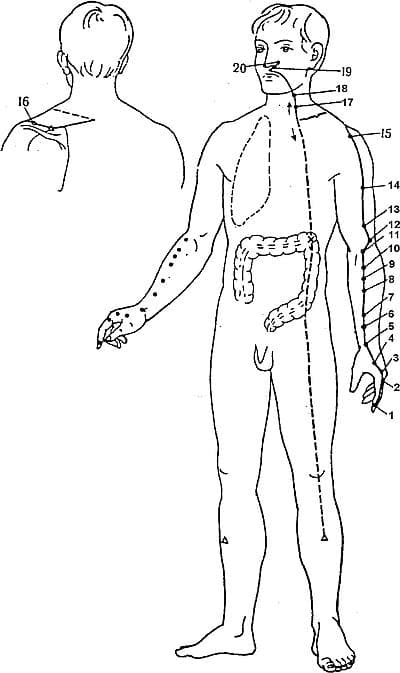
The Large Intestine Meridian (GI)
The meridian of the large intestine belongs to the Yang meridians. Its pair is the meridian of lungs and its element is metal. The maximum meridian activity is from 5:00 to 7:00 hours, and the minimum activity is from 17:00 to 19:00. It receives energy from the meridian of the lungs and transmits it to the meridian of the stomach, manual, includes 20 points.
Functions of the Large Intestine Meridian
This meridian receives the content of the small intestine, absorbs the remaining water, thickens the feces and removes it. It controls the removal of toxins from the body, affects the immune system and the condition of the skin. It is directly connected with the meridian of the lung.
According to the classical concept, this meridian has internal and external passages.
External stroke begins at the nail bed of the index finger. It rises along the radial side, passes between the first and second bones of the pastern and between the tendons of the muscles of the long and short extensors of the thumb. Further along the radial side of the forearm along the outer surface of the shoulder, passes into the area of the shoulder joint and passes between the shoulder joint and the acromial process of the scapula. Then it goes on its back to the da-zhui point, bends around the trapezius muscle and reaches the center of the supraclavicular fossa to the que-pen point, goes to the neck, cheek, goes to the center of the lower jaw gum, bends around the lips, crossing with the meridian of the same name at the zhen-zhong point and ends at the ying-xiang point at the wings nose.
The internal passage begins at the point of the stump, enters the chest cavity, goes to the lungs, wraps around in a spiral, follows along the aorta, passes down through the diaphragm, goes to the large intestine, where it branches.

Symptoms and Diseases Related to the Imbalance of The Large Intestine Meridian
Signs of redundancy
Constipation; pain in the shoulder, forearm, fingers; heat in the body; dry mouth, pain and bloating in the abdomen; headache; deterioration in the heat system.
Signs of insufficiency
Diarrhea; dizziness; feeling of weakness in the upper extremities; rumbling in the stomach; disorders of intestinal function; coldness in the body. A slight cough; redness of the posterior wall of the pharynx; rash; itching.
Diseases of The Large Intestine Meridian
Diseases related to the meridian of the colon: headache and toothache; nosebleeds; tinnitus; inflammation of the mucous membrane of the throat; constipation; hemorrhoids; a sharp decrease in blood pressure; fever; facial swelling; eye pain with glaucoma; pain in the shoulder joints; numbness of the fingers; skin and immune system diseases; pain manifestations in the joints of the hands; hypertension; dysbiosis; rheumatism; pain in the temples; problems with the nose; loss of smell; polyps in the nasopharynx; runny nose; rhinitis; tonsillitis; bronchial asthma; facial furunculosis.